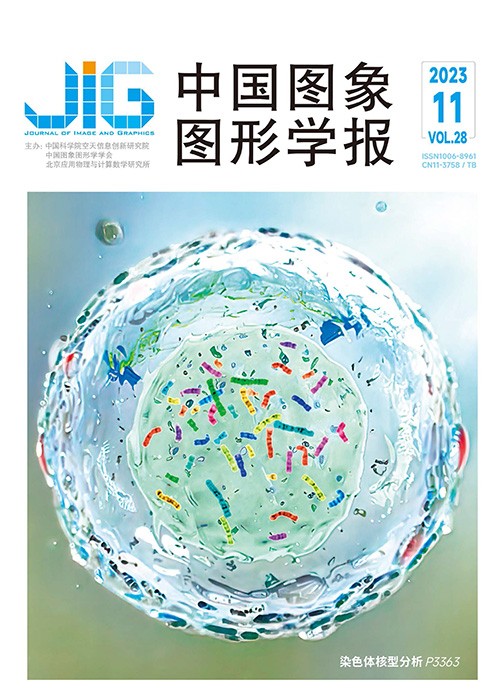
SSRGFD:双目超分辨率图像通用篡改检测数据集
尹承禧1,2, 张博林1,2, 罗俊伟1,2, 朱春陶1,2, 付婧巧3, 卢伟1,2(1.中山大学计算机学院广东省信息安全技术重点实验室, 广州 510006;2.中山大学计算机学院机器智能与先进计算教育部重点实验室, 广州 510006;3.中山大学信息管理学院, 广州 510006) 摘 要
目的 图像编辑软件的普及使得篡改图像内容、破坏图像语义的成本越来越低。为避免恶意篡改图像对社会稳定和安全的威胁,检测图像的完整性和真实性尤为重要。面对新型成像设备和算法,需要重新验证现有图像篡改检测算法的有效性并针对双目超分辨率图像的安全性展开进一步研究。但由于双目超分辨率图像篡改数据集的缺乏,难以满足研究的需要。为此,构建了一个双目超分辨率图像通用篡改检测数据集SSRGFD(stereo superresolution forensic general dataset)。方法 数据集构建考虑复制黏贴、拼接和图像修复3种常见的篡改类型。为使数据集图像更贴合真实篡改场景,本文从篡改图像内容和隐藏篡改痕迹两方面出发为不同篡改类型设计了不同的篡改标准。首先使用超分辨率算法PASSRnet (parallax attention stereo image super-resolution network)从Flickr1024数据集生成双目超分辨率图像,分别基于3种篡改标准通过手工或深度学习算法对图像进行篡改,构建了2 067幅篡改图像,并为每一幅篡改图像提供了对应的篡改区域掩膜。结果 实验从主观和客观两个角度评估数据集图像视觉质量。通过双刺激连续质量分级法得到的主观质量平均评分差异基本都低于1.5。客观质量评价方法BRISQUE(blind/referenceless image spatial quality evaluator)、NIQE(natural image quality evaluator)和PIQE(parent institute forquality education)的平均评估结果分别为30.76、4.248和34.11,与真实图像十分接近。实验使用多种检测方法在SSRGFD和单目图像数据集上进行比较。QMPPNet (multi-scale pyramid hybrid loss network)的性能指标均表现最优,但所有检测方法在SSRGFD上的性能相比于在单目图像数据集上的性能显著下降。结论 构建的SSRGFD数据集内容丰富且具有较好的视觉质量,能够为双目超分辨率图像篡改检测研究工作提供良好的数据支持。SSRGFD数据集可以从https://github.com/YL1006/SSRGFD上获取。
关键词
SSRGFD:stereo super-resolution image general forensic dataset
Yin Chengxi1,2, Zhang Bolin1,2, Luo Junwei1,2, Zhu Chuntao1,2, Fu Jingqiao3, Lu Wei1,2(1.Guangdong Province Key Laboratory of Information Security Technology, School of Computer Science and Engineering, Sun Yat-sen University, Guangzhou 510006, China;2.Ministry of Education Key Laboratory of Machine Intelligence and Advanced Computing, School of Computer Science and Engineering, Sun Yat-sen University, Guangzhou 510006, China;3.School of Business, Sun Yat-sen University, Guangzhou 510006, China) Abstract
Objective With the rapid development of computers and networks,images have become an important component of information transmission and sharing. However,the popularization of image editors reduces the cost of tampering with image content and destroying image semantics. To avoid the threat posed by malicious tampering images to social stability and security,the integrity and authenticity of images should be detected. The popularization of dual cameras and the development of stereo super-resolution methods have introduced stereo super-resolution images into many fields,such as photography,remote sensing,and intelligent robots. However,the characteristics of these images differ from those of monocular images. Faced with new imaging devices and algorithms,the effectiveness of existing image tampering detection algorithms needs to be revalidated,and the security of stereo super-resolution images should be further examined. Nevertheless,stereo super-resolution image tampering datasets are currently lacking,hence posing difficulties in meeting the needs of image forensics research. To this end,a high-quality stereo super-resolution image general forensic dataset (SSRGFD)is constructed in this paper. Method Forgery images in the SSRGFD dataset are all stereo super-resolution images generated using Adobe Photoshop and deep learning algorithms. Three common categories of forgeries are considered,namely,copy-move,splicing,and inpainting,of which inpainting includes removal and restoration. Stereo superresolution images are initially generated from the Flickr1024 dataset using the stereo super-resolution method PASSRnet. To enrich the image content and conceal visible traces of tampering,several tampering standards are designed for different forgery categories to make the tampering images in line with real scenes. Afterward,the copy-move and splicing stereo super-resolution tampering images are tampered using Adobe Photoshop based on these standards. In the copy-move stage, one or more duplicated regions are copied and moved to other appropriate regions on the image. In the splicing stage,one or more regions are replaced with duplicated regions from different images to synthesize the tampering image. Meanwhile, image inpainting involves the removal of some objects and the recovery of the missing region on an image. When removing image objects,the pixel in a certain range is picked up according to the image content to simulate the image background and cover the target object using Photoshop tools. Moreover,the HiFill deep learning method is used to recover the missing regions on these images. Due to the differences between the training images and the images to be tampered with,tampering images with obvious traces of inpainting are removed manually. For each forgery category,various preprocessing and postprocessing methods may be applied to cover visible traces of tampering according to the proposed standards. The masks of the tampered region corresponding to each tampering image are also provided. Result The subjective visual quality of the SSRGFD dataset is evaluated using the double stimulus continuous quality scale method,and the difference in the scores given by the evaluator between the tampering and real images is less than 1. 5. Among them,copy-move has the lowest score difference due to the fact that the duplicated and tampering regions come from the same image and that only few tampering traces are visible. Three no-reference image quality evaluation methods,namely,blind/referenceless image spatial quality evaluator(BRISQUE),natural image quality evaluator(NIQE),and parent institute for quality education(PIQE) are also applied for an objective visual quality evaluation. The evaluation results for the real and forgery images of the SSRGFD dataset are very similar. These experiments illustrate that forgery images have promising visual quality. To demonstrate the challenge posed by stereo super-resolution images to existing image tampering detection and localization methods,experiments are conducted using four effective models,namely,manipulation tracing network(MantraNet),ringed residual U-Net (RRU-Net),QMPPNet,and dense fully convolutional network(DenseFCN). These experiments use precision,recall,pixel-level F1 score,Matthews correlation coefficient(MCC),and intersection over union(IoU)as evaluation parameters for the methods proposed above. QMPPNet performs best in all metrics by combining semantic segmentation and edge features. The results of QMPPNet in precision,recall,pixel-level F1 score,MCC,and IoU are 0. 507 9, 0. 899 8,0. 614 8,0. 643 3,and 0. 480 2,respectively. However,compared with the monocular images forgery dataset, the performance of these methods on the SSRGFD dataset is greatly reduced. Conclusion This paper constructs a tampering dataset on stereo super-resolution images. These images greatly affect the performance of the existing image tampering localization methods and dramatically reduce the capability of these methods on stereo super-resolution images. Several experiment results have verified the necessity of new image forensic methods adapted for stereo super-resolution images. However,the existing monocular datasets cannot meet research needs. The SSRGFD dataset with affluent content and considerable visual quality not only brings great challenges to image forensic methods but also provides effective data support for the image tampering detection and localization of stereo super-resolution images. The SSRGFD dataset is available at https:// github. com/YL1006/SSRGFD.
Keywords
digital image forensic image tampering detection stereo super-resolution image tampering dataset copymove splicing inpainting image visual quality evaluation
|



 中国图象图形学报 │ 京ICP备05080539号-4 │ 本系统由
中国图象图形学报 │ 京ICP备05080539号-4 │ 本系统由